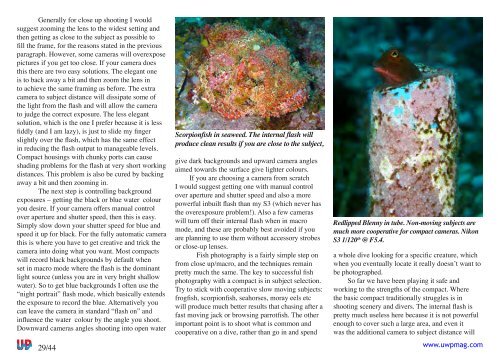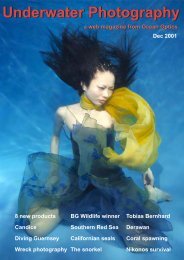Underwater Photography - SENSACIONES.org
Underwater Photography - SENSACIONES.org
Underwater Photography - SENSACIONES.org
You also want an ePaper? Increase the reach of your titles
YUMPU automatically turns print PDFs into web optimized ePapers that Google loves.
Generally for close up shooting I would<br />
suggest zooming the lens to the widest setting and<br />
then getting as close to the subject as possible to<br />
fill the frame, for the reasons stated in the previous<br />
paragraph. However, some cameras will overexpose<br />
pictures if you get too close. If your camera does<br />
this there are two easy solutions. The elegant one<br />
is to back away a bit and then zoom the lens in<br />
to achieve the same framing as before. The extra<br />
camera to subject distance will dissipate some of<br />
the light from the flash and will allow the camera<br />
to judge the correct exposure. The less elegant<br />
solution, which is the one I prefer because it is less<br />
fiddly (and I am lazy), is just to slide my finger<br />
slightly over the flash, which has the same effect<br />
in reducing the flash output to manageable levels.<br />
Compact housings with chunky ports can cause<br />
shading problems for the flash at very short working<br />
distances. This problem is also be cured by backing<br />
away a bit and then zooming in.<br />
The next step is controlling background<br />
exposures – getting the black or blue water colour<br />
you desire. If your camera offers manual control<br />
over aperture and shutter speed, then this is easy.<br />
Simply slow down your shutter speed for blue and<br />
speed it up for black. For the fully automatic camera<br />
this is where you have to get creative and trick the<br />
camera into doing what you want. Most compacts<br />
will record black backgrounds by default when<br />
set in macro mode where the flash is the dominant<br />
light source (unless you are in very bright shallow<br />
water). So to get blue backgrounds I often use the<br />
“night portrait” flash mode, which basically extends<br />
the exposure to record the blue. Alternatively you<br />
can leave the camera in standard “flash on” and<br />
influence the water colour by the angle you shoot.<br />
Downward cameras angles shooting into open water<br />
Scorpionfish in seaweed. The internal flash will<br />
produce clean results if you are close to the subject,<br />
give dark backgrounds and upward camera angles<br />
aimed towards the surface give lighter colours.<br />
If you are choosing a camera from scratch<br />
I would suggest getting one with manual control<br />
over aperture and shutter speed and also a more<br />
powerful inbuilt flash than my S3 (which never has<br />
the overexposure problem!). Also a few cameras<br />
will turn off their internal flash when in macro<br />
mode, and these are probably best avoided if you<br />
are planning to use them without accessory strobes<br />
or close-up lenses.<br />
Fish photography is a fairly simple step on<br />
from close up/macro, and the techniques remain<br />
pretty much the same. The key to successful fish<br />
photography with a compact is in subject selection.<br />
Try to stick with cooperative slow moving subjects:<br />
frogfish, scorpionfish, seahorses, moray eels etc<br />
will produce much better results that chasing after a<br />
fast moving jack or browsing parrotfish. The other<br />
important point is to shoot what is common and<br />
cooperative on a dive, rather than go in and spend<br />
Redlipped Blenny in tube. Non-moving subjects are<br />
much more cooperative for compact cameras. Nikon<br />
S3 1/120 th @ F5.4.<br />
a whole dive looking for a specific creature, which<br />
when you eventually locate it really doesn’t want to<br />
be photographed.<br />
So far we have been playing it safe and<br />
working to the strengths of the compact. Where<br />
the basic compact traditionally struggles is in<br />
shooting scenery and divers. The internal flash is<br />
pretty much useless here because it is not powerful<br />
enough to cover such a large area, and even it<br />
was the additional camera to subject distance will<br />
29/44 www.uwpmag.com

















